Drip Coffee vs Flat White: What Differs Between These Brews?
Drip coffee and flat white are 2 coffee beverages that you’ll find on the menu of pretty much every coffee shop. Their name doesn’t tell much about them, so you might have found yourself in a situation, where you skim over them, since you didn’t know what they were.
Don’t worry, every barista has been there. Let me shed some light on the topic with this comprehensive comparison between these two coffees where I’ll discuss their ingredients, ratios, flavors, and more.
Key Takeaway – What’s the difference between a Flat white and drip coffee?
Drip coffee is simply made by pouring hot water over ground coffee beans and filtering the coffee that dips out below, resulting in a clean and smooth drink that highlights the bean’s nuances. In contrast, the flat white uses a potent double espresso or double ristretto and combines it with 2 parts steamed milk for a coffee that’s both bold and creamy.
Let’s get into the details.
What is Drip Coffee?
Filter coffee, also known as drip coffee, has become a staple in homes since the early years of the 20th century, especially in the United States. The process for making it is pretty easy – hot water needs to be poured over ground coffee and then filtered out. It will slowly drip into your mug or pot.
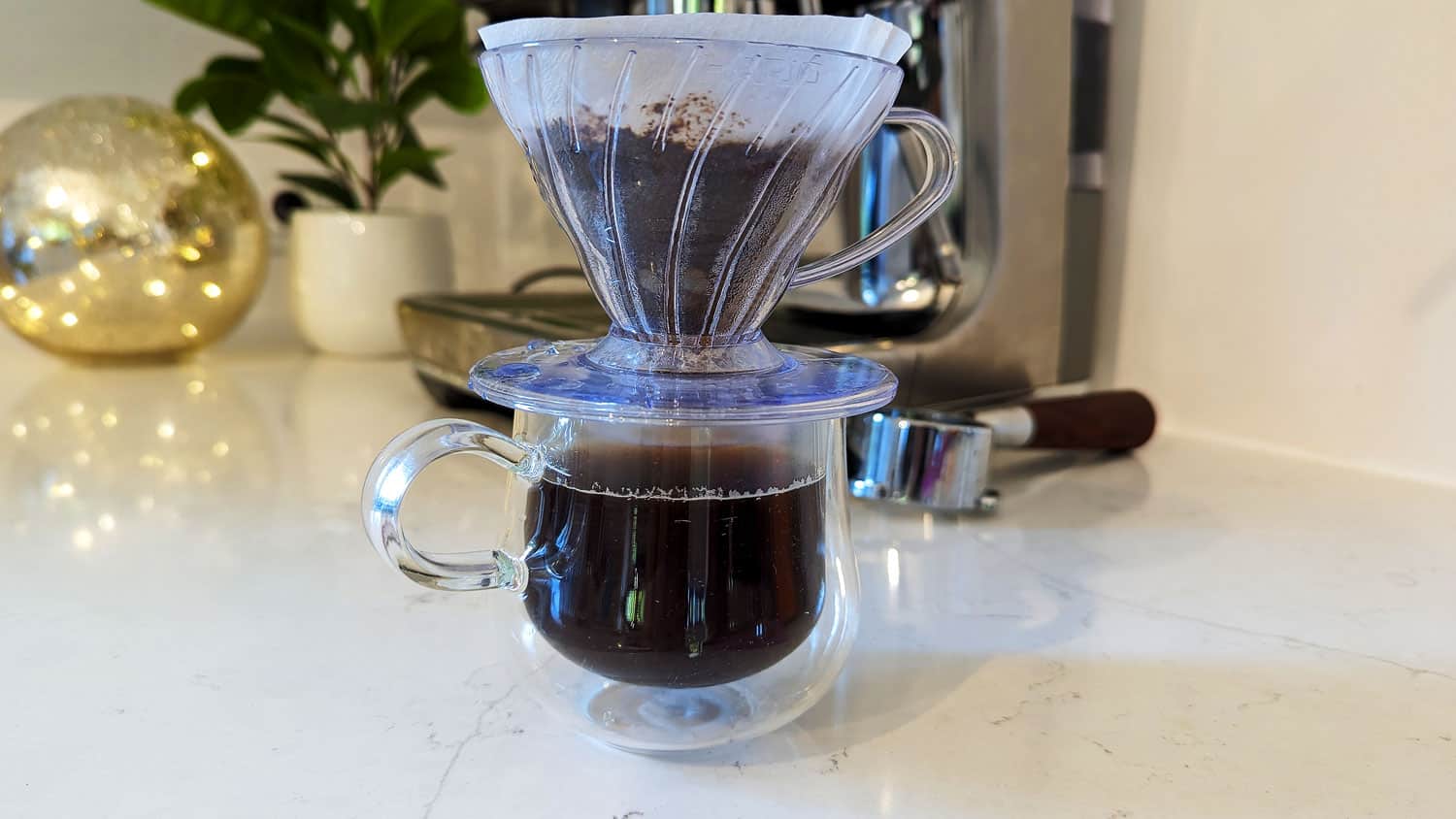
Drip coffee can be created with a coffee machine, a V60, Chemex, or any other apparatus that lets the coffee drip through a filter.
There’s the Golden Ratio to meet in drip coffee, which is 1:16 and 1:17. This means for that for 1 g of coffee, you use 16-17 g of brewing water. So for example, a serving size of 6oz would need 11g of coffee grounds. I serve it in mugs that can hold 240-300 ml (8-10 oz). With this serving amount, I get a kick with its caffeine content of 50 to 90mg while maintaining a measly two calories.
About the taste, drip coffee possesses subtler flavors compared to espresso. Its charming simplicity lets the subtle notes of the beans through, like citrus, chocolate or even floral tones. I personally enjoy its light and watery texture which allows me to savor longer sips of coffee. In fact, I’m having one right now, as I write this article 🙂
Here’s how you can make it with a home coffee machine:
- Grind your coffee to medium coarse.
- Add water to the machine’s reservoir.
- Place your filter and add the coffee grounds.
- Hit the “brew” button and wait for your coffee to be ready.
For more details, check out my guide on how to use a drip coffee maker.
Now let’s talk about the flat white.
What is a Flat White?
Originating from Australia, the flat white is a coffee drink that could be mistaken for a latte or cappuccino. But what sets it apart is its increased espresso-to-milk ratio, giving it a stronger coffee taste.
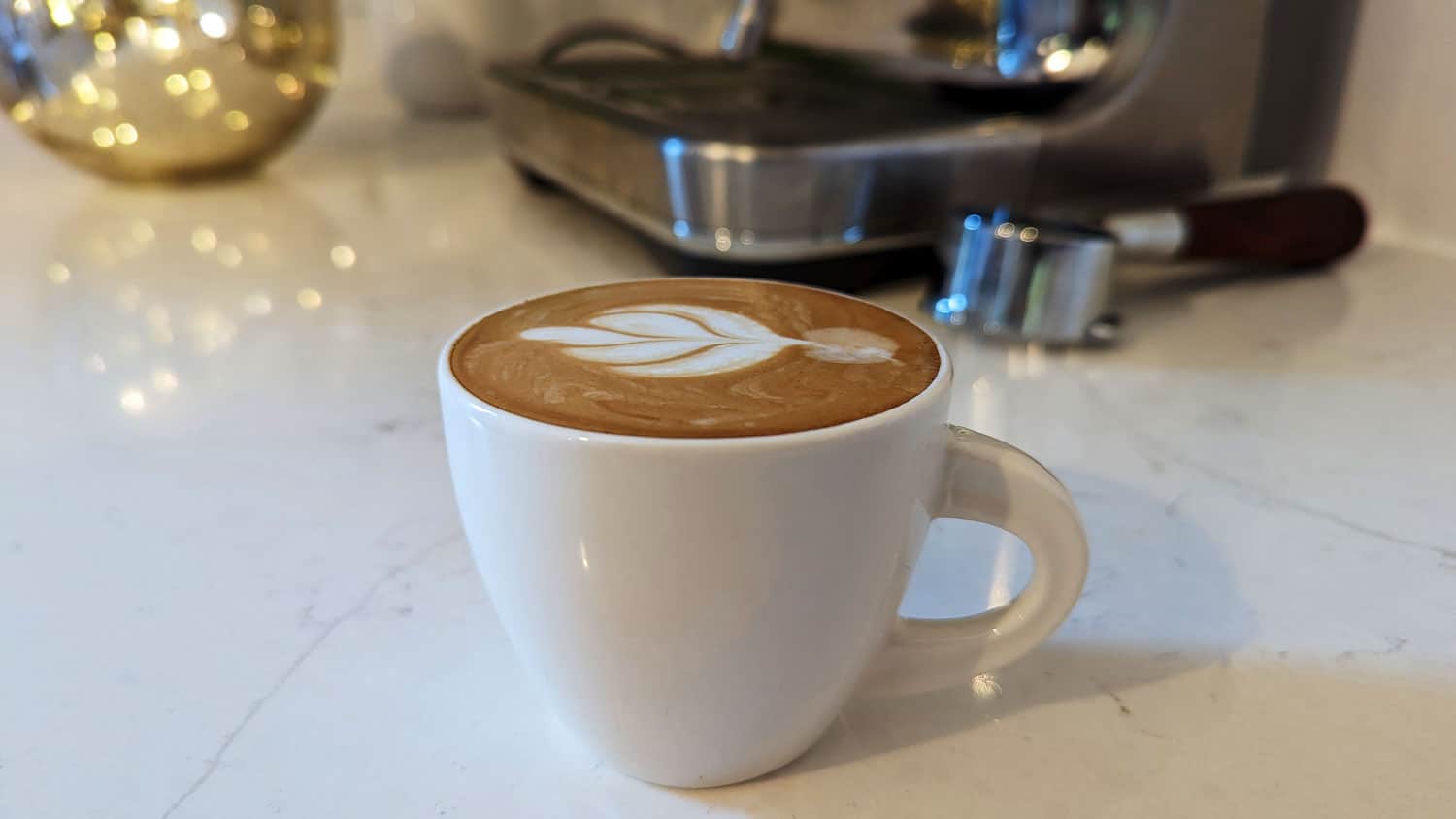
The base of a flat white is a double espresso with a coffee-to-water ratio of 1:2 and 1:3. Or you can choose a double ristretto, which has a brew ratio of 1:1.5.
For each base, you’ll use 14g of ground coffee if you want it traditional style or up your dose to 18g if you are going for third-wave coffees.
Once done, you prepare steamed milk with fine mocrofoam, and you combine the coffee with two parts steamed milk providing a total volume of about 150-180ml (5-6 oz). This mix fits perfectly in dome-shaped cappuccino cups with capacities ranging from 150-210 ml (5-7 oz).
You get 120–160mg of caffeine from a double shot of either espresso or ristretto in this drink. Owing to the milk portion, your flat white delivers 58 calories per serving. You can lower the calorie count by using plant-based milk alternatives, but they will taste different than an authentic flat white.
Now onto its taste. The flat white’s distinguishing feature is its intense yet harmonious flavor. The potency of the espresso shines through but does not overpower because it gets balanced by the milky sweetness accompanying it. Additionally, there’s its texture – it’s velvety smooth with just a bit of frothiness from the thin silky microfoam layer melding with the espresso.
The drink is a recent “invention” of the 3rd coffee wave, so it requires some barista skills to prepare. Here are the steps, but be warned, it’s not that easy. In fact, it’s words apart from preparing a simple drip coffee.
- Prepare a double espresso or double ristretto.
- Pour cold milk into a steaming pitcher until it reaches the bottom of the spout.
- Heat and steam the milk to around 160 degrees Fahrenheit while aerating it to achieve that silky texture with microfoam.
- Pour the steamed milk into the cup, making sure that the thin microfoam layer is level with the top of your cup.
- Add latte art if you can.
To nail this recipe and read about the details, check out my detailed guide on how to make a perfect flat white.
Drip Coffee vs Flat White: A Detailed Comparison
Let’s break down the similarities and differences between drip coffee and flat white with a side-by-side comparison:
| Aspect | Drip Coffee | Flat White |
|---|---|---|
| Taste and Texture | Milder, clean taste that emphases the notes of the beans it is made of; light and watery texture. | Strong yet balanced flavor; velvety smooth texture with a thin layer of microfoam blending with the espresso. |
| Coffee-to-Water Ratio | 1:16-1:17 | Espresso: 1:2 to 1:3 / Ristretto: 1:1.5 |
| Ingredient Ratio | Just coffee | Double espresso/double ristretto, 2 parts steamed milk, & thin layer of microfoam |
| Typical Serving Size | 6 oz (180 ml) | 5 to 6 oz (150 to 180 ml) |
| Caffeine Content | 50-90 mg per 6oz cup | 120-160 mg for the double shot of espresso/ristretto |
| Calories | 2 calories per 6 oz cup | 58 calories for a 150 ml serving |
| Acidity | Generally moderate acidity | Low to moderate acidity |
| Brewing Difficulty | Easy | Home barista |
| Bean Roast | Light to medium roasts | Medium and dark roasts |
I will now break down the comparisons between these two coffee drinks:
- Ground Coffee Weight & Ratios: Drip coffee uses 11g of coffee for a 6oz serving with a ratio of 1:16-1:17. In contrast, flat white uses more coffee grounds, 14g (18g for third-wave coffee) for a double shot of either espresso (1:2 to 1:3 brew ratio) or ristretto (1:1.5). To complete the flat white, the coffee is combined with 2 parts steamed milk with a microfoam layer.
- Taste: Drip coffee offers a milder profile, allowing the nuanced flavors of the beans to come through, be it citrus, chocolate, or floral hints. On the other hand, flat white boasts a strong yet balanced profile, with the espresso’s boldness harmonizing with the creamy sweetness of milk.
- Volume, Calories, & Caffeine: Drip coffee comes in servings of 6oz with 50 to 90mg of caffeine and only 2 calories. Because of the doubled shots of coffee and the added milk, a serving of flat white ranges from 5 to 7 oz, comes with 120-160mg of caffeine, and has a calorie content that starts at 58 calories.
- Bean Roast: For drip coffee, I choose light to medium roasts because the coffee beans’ bright and nuanced flavors are emphasized. I opt for medium and dark roasts when brewing flat white because these roasts work well with milk.
- Steamed Milk: While drip coffee is drank pure, flat white uses 2 parts milk for every double shot of coffee. You can use full-fat milk but alternatives like soy, almond, or oat milk also work. Here is my guide on how to steam milk if you’re new to it.
- Serving Suggestions: Drip coffee pairs wonderfully with breakfast, and there’s room to play with variations. For example, I like making cinnamon coffee during the fall.
Flat white, being a more robust drink, is great if you’re seeking an extra caffeine kick while craving some creaminess in your cup.
As you can see, drip coffee and flat white are very different, starting from their brew ratios and methods to their final flavors. Still, they both showcase the nuances of the coffee beans used.
Which do you like better?
Now it is your turn, which drink will you try next time you go to a cafe?

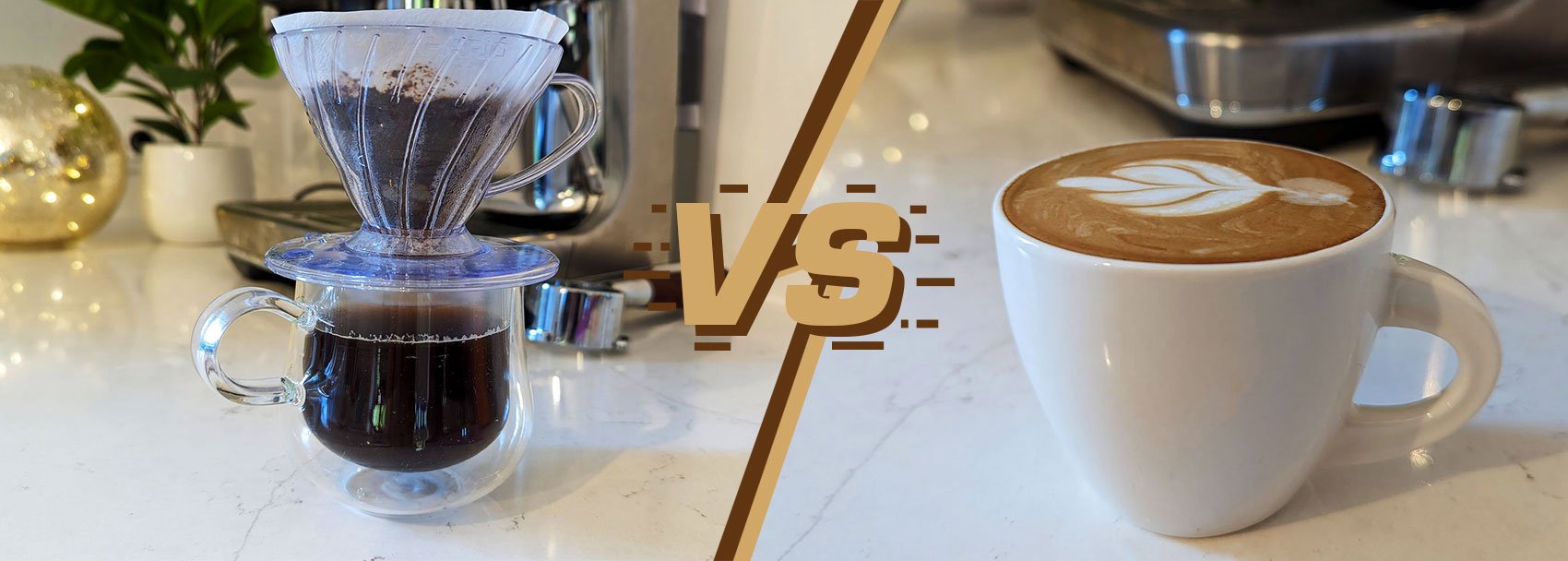
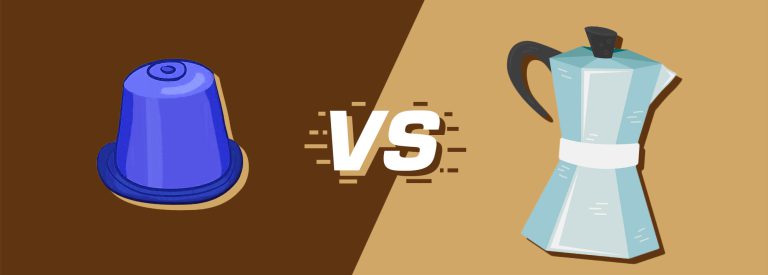
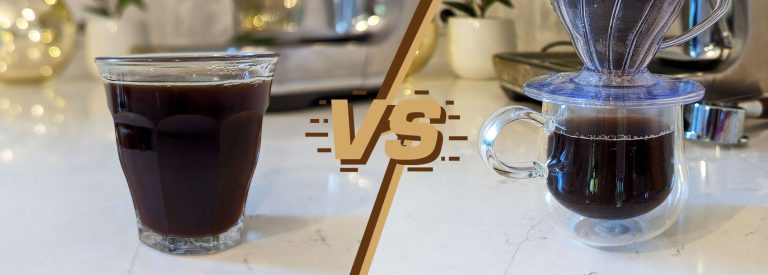
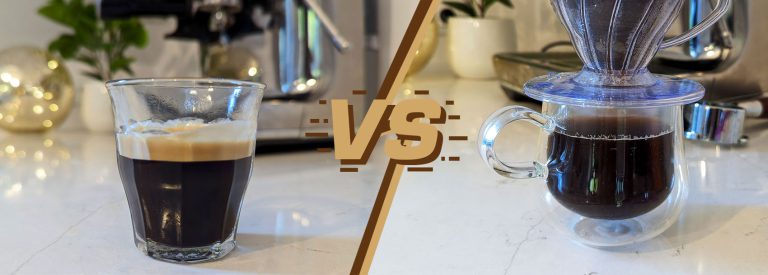

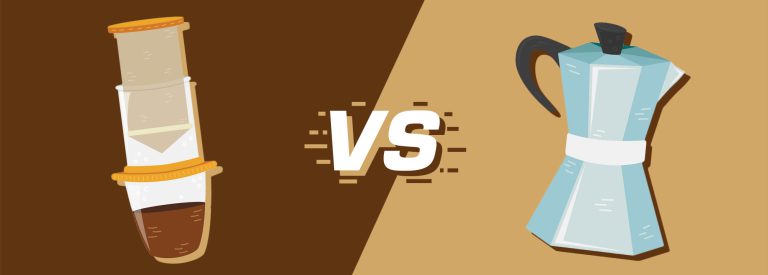
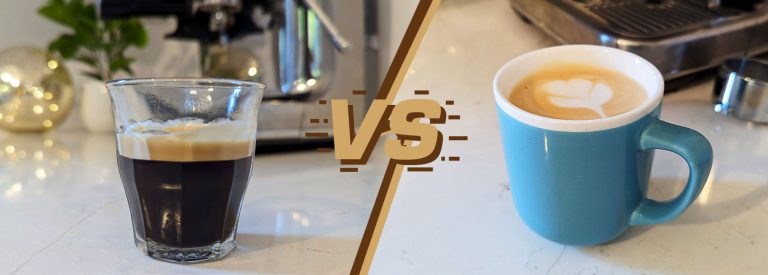

I think it’s also worth mentioning how the water temperature can affect drip coffee’s extraction and flavor profile. Perhaps, Tom, you might consider including this in your next comparison article, as I believe it could add another level of understanding for coffee enthusiasts.
Quick question, Tom. You mentioned a range of brewing water ratios for the golden ratio in drip coffee making. Could you clarify how the taste profile changes when you swing from 1:16 to 1:17? Does that small adjustment make a noticeable difference, or is it more about personal preference?
It is a personal preference. The larger the ratio, the lighter tasting the coffee will be since you’re pouring more water through the same amount of grinds.
I’ve got to hand it to you, Tom, your article was a godsend, I’m actually at the café writing this 🙂 I found myself not knowing the difference between a drip coffee and a flat white, the friends I’m with ordered them, and did a quick search. Felt sort of silly, but now I know.
Tom, after reading your article, I tried making drip coffee at home following your golden ratio and it turned out great. It had a much cleaner taste compared to my measuring scoop “measurements”.